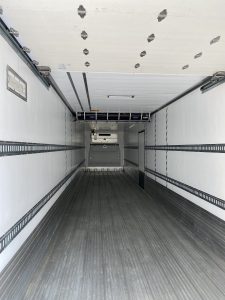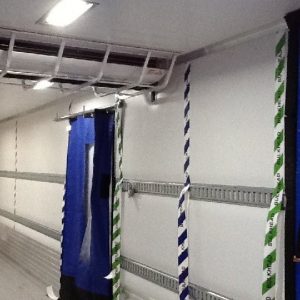Today, getting essential products to refill our Nations Foods Supply Chain is more critical than ever. There is a complexity to logistically loading so many various types of different products. From a field of lettuce in California, Florida strawberries, fresh seafood on the coast lines, along with ice cream, soaps & dry goods makes complying with today’s Food Standards Regulations no easy task. A professional distribution center must take in a variety of goods and then reload them properly to be delivered to your nearest restaurant, chain store, or “C” store. Keeping these goods separated into their proper temperature zone throughout the delivery takes experience and technique.
We have a team of specialist that through past Multi-Temp applications, have provided solutions for several household names over the last 25 years. The single most important thing for them to remember is to insure they build in enough flexibility in their equipment for future growth. Multi-Temps can be expensive. If you make a specification mistake, most companies will live with that mistake for at least 10-15 years. Taking the necessary time to build it right the first time will reduce a customers overall cost, increase the life of the equipment, and improve companies efficiencies all while keeping drivers safety a #1 priority.
Our Multi-Temp specialists start with a series of questions. We like to get the customers’ entire team involved including the warehouse and drivers when designing a Multi-Temp solution. We have made in-person deliveries with our customers in over 16 states to help us understand their business first hand. What looks good on paper might not always be the best solution for delivering temperature sensitive product to the customer. To route deliveries for a company is a critical job that has lasting impact on the company’s bottom line as well as the integrity of the product they are delivering. When the warehouse loads a pallet of water with ambient temperature of their warehouse next to a pallet of lettuce pulled from their cooler, this co-mingle of product can reduce the overall shelf life of the lettuce.
Educating our customer base on this type of equipment they just purchased is equally as important. These are expensive trailers and dropping them off at their facilities expecting drivers and warehouse personnel to know how to operate them correctly is a challenge.
We were approached by a company approximately 23 years ago to help with their trailer fleet. At the time this customer had (18) Distribution Centers across the United States, and each location had different delivery practices with (38) different trailer configurations.
Their equipment consisted of 48’ trailers with (4) Side Doors and a rear lift gate. This company allowed us to observe their loading and unloading practices at (16) of their facilities and we then came back with recommendations.
This company created a standardization committee consisting of executives, Drivers and Operations managers who each came to the meetings with (10) routes from each of the different Distribution Centers.
Craftsmen Utility Trailer created a custom model to create different configurations & temperature zones based on individual DC’s requirements. It allowed a conscience on (2) different configurations, eliminating (3) side doors adding side gates and flexibility for future customers, without jeopardizing product integrity.
Multi-Temp Trailers are for more than just food
• Paint / Stains (Today most are water based and will freeze)
• Pet Food
• Chemicals
• Bio- Science
• Pharmaceuticals
• Beverages




